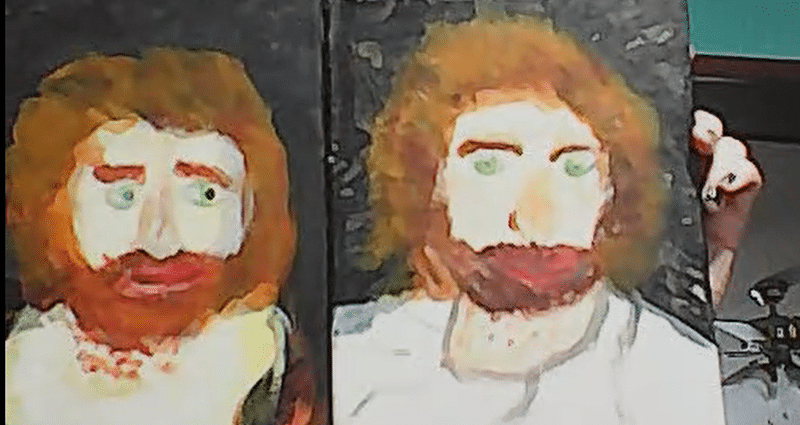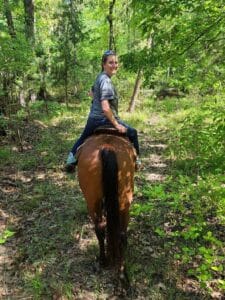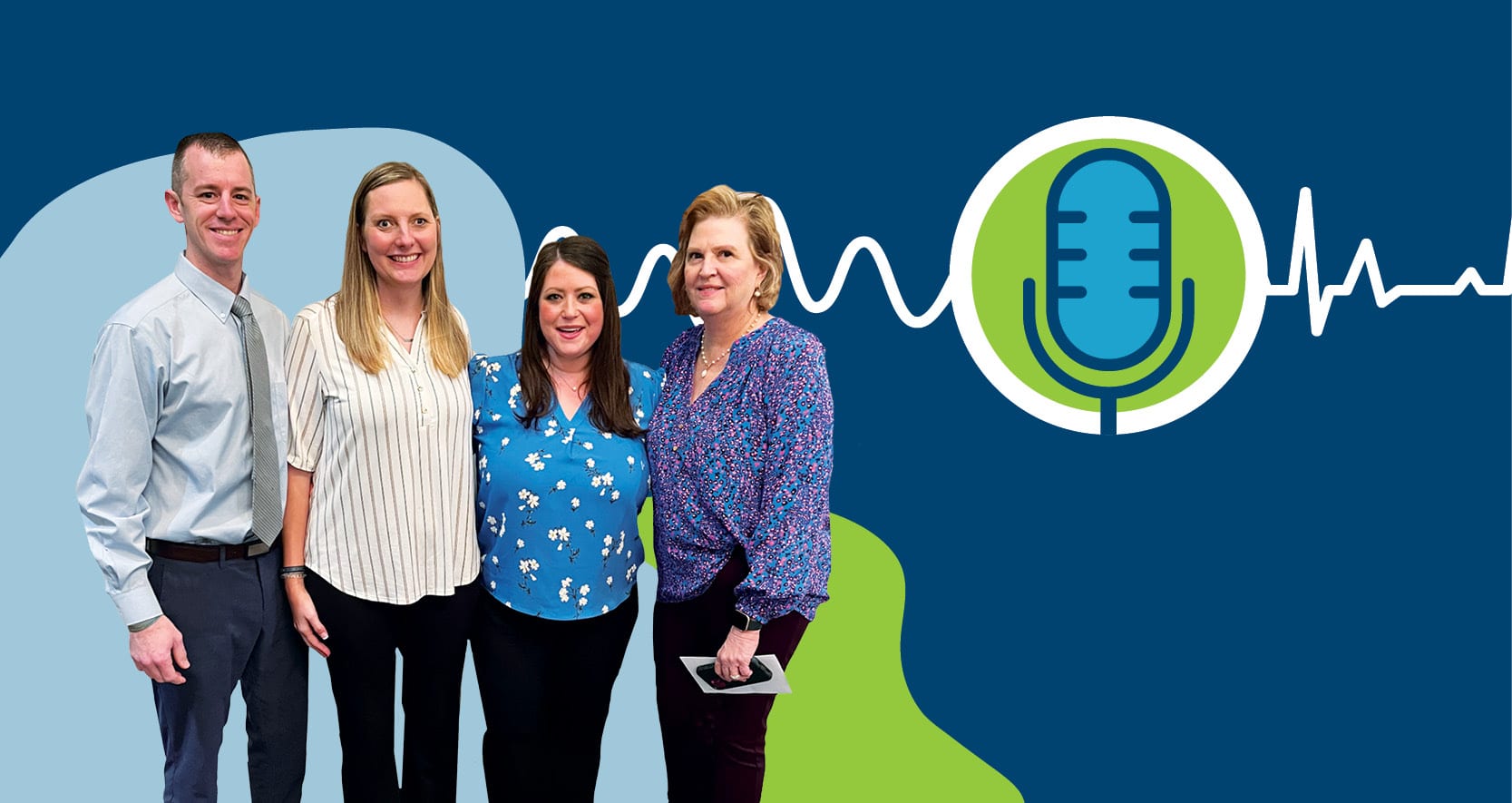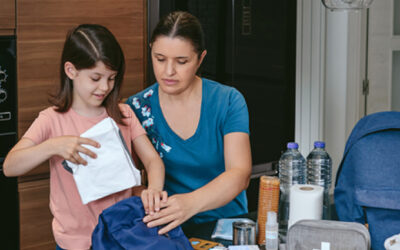Last year, a young mom from Meridian, Mississippi, experienced an uncommon type of stroke, a subarachnoid hemorrhage, and was airlifted to St. Dominic Hospital for treatment at its Comprehensive Stroke Center.
Lauren Pogue, now 36, not only survived, but she has experienced phenomenal recovery. She and her husband, Jeremy, shared their experience in this episode of our podcast, The Doctor Will Hear You Now.
Helicopter in the Front Yard
Jeremy is a flight paramedic working for an air medical company. He had just gotten home from work on March 2, 2022, when it happened. Everything was normal leading up to the stroke.
“We didn’t know Lauren had any type of neurological compromise,” Jeremy says. “It caught everybody off guard.”
While she was still able to speak clearly, Lauren pointed to her left temple, which was a thunderclap headache, but then her speech got slurred and she passed out. When she woke up, her speech had changed and nothing she said made sense.
“I don’t remember much,” Lauren says. “I did pass out and then the helicopter was here.”
Jeremy realized what was going on once Lauren passed out a second time.
“We’re a good 35 minutes from the nearest hospital, and it’s not a stroke center,” Jeremy says. Thankfully he was able to call the company he worked for. “I’ve transferred a lot of injured and sick brains around the state. There wasn’t a question mark of where to go – St. Dominic’s.”
The family lives a two-hour drive from St. Dominic’s in Jackson, with their three daughters, 8, 10 and 12. Jeremy was able to arrange an ambulance helicopter landing in their front yard. The crew treated and stabilized Lauren immediately on site and took her directly to St. Dominic Hospital to treat her hemorrhagic stroke.
“From the time this happened, care was turned over in 55 minutes,” Jeremy says. “The timeframe was really miraculous. It’s a big part of why she has recovered.”
Care at St. Dominic’s
A multidisciplinary team surrounded Lauren to provide her care. A procedure to coil the aneurysm was initially planned to stop the bleeding, but the team decided a craniotomy clipping would yield the best results.
Neurosurgeon Paul Kerr, MD, scheduled it for the next day. The neurosurgery procedure opened her skull to stop the bleeding and decrease further risk, and was overall successful. However, Lauren hit a lot of roadblocks along the way. Lauren’s left internal carotid artery was so damaged it had to be sacrificed. After waking up from the craniotomy, Lauren experienced vasospasms, meaning a brain blood vessel narrowed, blocking blood flow, which created new deficits.
“How they overcame those and navigated around such unexpected turns was phenomenal,” Jeremy says. “I’ve transported patients around the state and surrounding states for years, and that level of care is just hard to put into words.”
Lauren was paralyzed for about two and a half weeks, but she did regain movement — from a wheelchair to being able to walk again. Her speech took much longer, but she’s made huge progress and has come a long way in the year since her stroke.
After being in the neuro intensive care unit, Lauren was moved to a regular room. She was in the hospital for about three weeks, then two weeks as an inpatient at a rehab center before she came home on April 6, 2022.
Ruth K. Fredericks, MD, co-medical director of St. Dominic Hospital’s Comprehensive Stroke Center, was Lauren’s neurologist, and Amber Herron, the center’s program manager, was also part of Lauren’s care team. In the podcast episode, they reflect on Lauren’s recovery.
“The first time I saw her, she was in ICU and could barely hold her head up,” Herron says. “By the time she left, she was walking with a moderate amount of assistance.”
Dr. Fredericks says, “We didn’t think how well she could recover and didn’t expect her to come back as far as she did. There are a lot of stories like Lauren’s now in the world of stroke care and recovery.”
God’s Hand on Everything
After the helicopter ride, Lauren doesn’t remember much until she was extubated.
During her surgery, Lauren had an encounter with God. “He made the way for me, and when I was in the hospital he showed me,” Lauren says. “I was with him, I saw him and God was with me.” He told her: “You’re going to be OK.”
The family relied on their faith, with God at work every step of the experience.
“God uses doctors and nurses and anybody in the medical field to help people recover,” Jeremy says. “It’s unbelievable what’s occurred over the last year.”
Lauren painted these images of what she saw during her surgery:

Motherhood
Although Lauren lost her ability to move and communicate for a while, she never lost her motherly instinct. One of the first things she asked about was her daughters when she woke up after surgery.
COVID-19 restrictions were still in place, but St. Dominic’s was able to accommodate the family’s request and let Lauren see her girls. Lauren could only stay awake for 10 or 15 minutes a time, but they were able to have a few minutes together.
“It was a pretty cool, private moment,” Jeremy says. “Looking back, it was a big turning point in her mental status — wanting to get better. It was huge, a breath of fresh air.” He says it helped Lauren push forward and work hard in therapy to get back on her feet and get home.
Making it Home
Preparing to go home meant making sure they had the equipment needed for Lauren to transition from an inpatient care environment, but she wanted none of it.
Jeremey recalled the amazing moment when they first arrived home and he got the wheelchair ready to bring her inside.
“She said ‘Leave it,’ walked from the vehicle into the house, sat on the couch and we were home at that point,” Jeremy says. “It was so good to be home. She was done with the wheelchair: bye.”
Lauren experienced another uptick in her recovery by being home.
“Just being somewhere where you sleep better, feel better and have that comfort of home, that was fantastic and major for her recovery,” Jeremy says.
A Year Later
 “A lot more goes into a patient’s recovery than a surgeon or neurologist or nurse’s capability,” Jeremy says. “It’s also the support you get in and around the procedure, and it’s absolutely the difference between recovery and someone living with major deficits the rest of her life.”
“A lot more goes into a patient’s recovery than a surgeon or neurologist or nurse’s capability,” Jeremy says. “It’s also the support you get in and around the procedure, and it’s absolutely the difference between recovery and someone living with major deficits the rest of her life.”
Lauren is living with some speech and vision deficits, but everything else is pretty much unaffected, which is very uncommon in patients who’ve had subarachnoid hemorrhages.
Before her stroke Lauren often rode horses, and Jeremy remembers the advice Dr. Fredericks gave her at discharge: “Tighten up your boots, but it’s going to be a rough ride,” which was very fitting. Since recording the episode, Lauren has been able to get back on her horse and return to riding.
“Most people don’t have this level of recovery,” Jeremy says. “We’re blessed and fortunate and realize that.”




